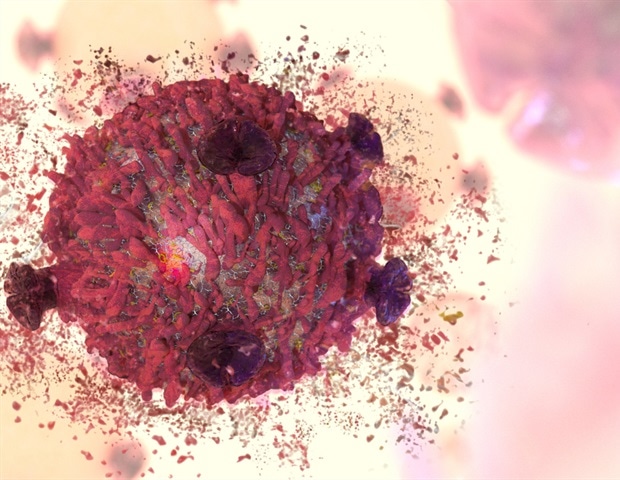
Researchers at Rutgers Cancer Institute of New Jersey and Rutgers New Jersey Medical School (NJMS), together with other collaborating groups, have discovered the first lipid vascular ‘ZIP code’ in the lungs. Getting a drug to where it is needed in the human body is critical for successfully treating diseases including cancer and avoiding toxic side-effects, but it remains a major challenge. One creative option has been to identify the unique protein receptors that are present on the surface of blood vessels at specific sites in the body that act like vascular ZIP codes. These ZIP codes can be physically paired with a ligand such as a small protein or antibody that can be harnessed to guide and deliver a package such as a drug or a diagnostic imaging agent to their specific molecular addresses. Some of these ligand-receptor pairs are already undergoing testing in clinical trials with anti-cancer and anti-obesity drugs.
Prior to the researcher’s findings, all vascular ZIP codes have been proteins. Their discovery uncovers a previously unrecognized lipid network of ZIP codes in blood vessels and opens up a new world of possibilities for improved diagnostics and treatments, including patients with severe human respiratory diseases such as emphysema, COVID-19, COPD and lung cancer.
In 2008, the researchers discovered a ligand peptide that bound to the surface of lung vascular endothelial cells and could deliver a cell death notice directly to the lungs in mice. However, their usual biochemical and genetic methods failed to identify the corresponding lung vascular ZIP code that the ligand was binding to.
The problem was that we had been looking for a protein. Our long series of frustrating failures led us to consider that the elusive target might be another type of molecule, perhaps a lipid; that was a eureka moment.”
Wadih Arap, MD, PhD, director of Rutgers Cancer Institute at University Hospital Newark, professor and chief of the Division of Hematology/Oncology, Department of Medicine, Rutgers NJMS and a co-lead author
The lipid ZIP code that they discovered on lung blood vessels is called C16-ceramide (also known as palmitoyl ceramide). It belongs to a family of closely related lipid molecules that perform many important cellular functions. These include helping viruses like Ebola and SARS-CoV-2 get into cells, and also triggering cell death. Increased levels of ceramides have long been known to be associated with many lung diseases. Thus, C16-ceramide represents an unexplored avenue for many different diagnostic or therapeutic applications. As Renata Pasqualini, PhD, a resident member of Rutgers Cancer Institute and chief of the Division of Cancer Biology, Department of Radiation Oncology at NJMS another co-lead author remarked, “imaging plays such an essential role in evaluating the lungs-;both, anatomically and functionally-;that we felt it was an opportunity to make a clinical difference. Whether it is for pulmonary screening, establishing a diagnosis, or monitoring disease severity, our approach and findings will hopefully represent an advance in this area.”
To solidify their discovery of a new lipid vascular ZIP code and ligand pair, they tested their hypothesis in genetically engineered ceramide-deficient mice and showed that the ligand was no longer able to target the lungs. To begin to demonstrate what this might mean for patients, they tested two candidate medical applications. First, they showed that it could potentially be used for early diagnosis and monitoring of certain lung diseases by attaching the ligand to gold nanoparticles, which specifically lit up the lungs by using optical and molecular imaging techniques. Finally, given the ongoing COVID-19 pandemic, they showed that the ligand could also deliver a novel vaccine directly to the lungs and stimulate a local immune response, which could be more protective than currently existing vaccines that are injected into the arm.
Daniela Staquicini, PhD, resident member of Rutgers Cancer Institute and assistant professor of the Division of Cancer Biology, Department of Radiation Oncology at Rutgers NJMS said, “this body of work actually encompasses an ensemble of three recently published manuscripts-;including this one-;on targeting different ZIP codes in the lung for multiple potential applications including non-invasive imaging and vaccine delivery, in which I had the privilege to serve as a co-first-author on behalf of several large teams of investigators.”
Next, the team plans to focus on discovering more lipid vascular ZIP codes in the blood vessels that serve other organs and particularly tumors as a way to better target anti-cancer drugs and will work to further translate these discoveries into true clinical applications for patients.
Source:
Rutgers Cancer Institute of New Jersey
Journal reference:
Staquicini, D. I., et al. (2023) Ceramide as an endothelial cell surface receptor and a lung-specific lipid vascular target for circulating ligands. PNAS. doi.org/10.1073/pnas.2220269120.










